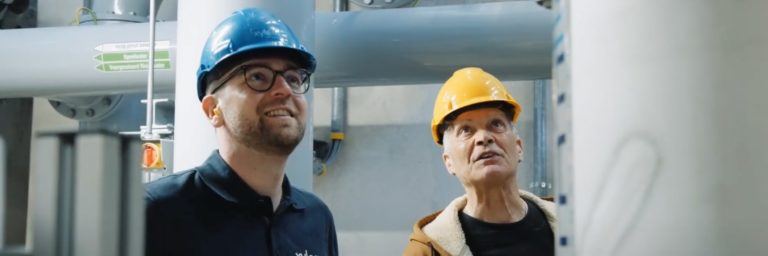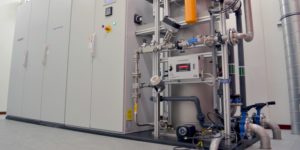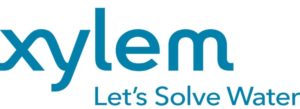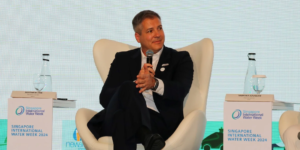Xylem and Dunea Develop First Sequential Advanced Oxidation Process (AOP) System

Xylem and Dunea Develop First Sequential Advanced Oxidation Process (AOP) System (Image source: Xylem Inc.)
The utility began pre-purifying river water and then piping it to coastal dunes, using the sand to naturally filter water as part of the utility’s treatment processes to bring surface water to drinking standards. However, as time went on, the utility began to grapple with another growing problem: micropollutants. In 2005, the utility began an ambitious project with Xylem to find an innovative way to address this critical challenge.
Getting a head start on a growing micropollutant problem
Micropollutants in water supply sources are a growing problem for water utilities. These chemical traces come from industries, agriculture, households and hospitals. This category of pollutants can include pharmaceuticals, endocrine disrupting compounds, personal care products, industrial chemicals, pesticides and contrast agents used in medical imaging.
Although the pollutant concentrations gave no reason for concern according to drinking water standards, Dunea decided to invest in developing strategies and water treatment solutions to mitigate and get ahead of the challenge. These long-sighted investments would help prevent the accumulation of micropollutants and improve the biodegradability of micropollutants in Dunea’s treatment train. In addition, the investments would help ensure compliance with any drinking water regulations that could arise in the future.
Micropollutants can effectively be removed from water with ozone oxidation. However, Dunea’s source water contains bromide, which eventually can be transformed to toxic bromate – a potentially carcinogenic substance – when ozone is used to treat water. Dunea’s goal was to find a solution for eliminating micropollutants while simultaneously forming 20 times less bromate than the World Health Organization (WHO) defines as safe for drinking water.
Finding the right combination of AOPs
The first phase of Xylem’s pilot study at Dunea, between 2007 and 2011, focused on what combinations of advanced oxidation processes would be best able to reduce four representative micropollutants.
There are three main, non-chlorine-based ways that water utilities treat drinking water by oxidation:
1. Ultraviolet light (UV)-AOP, 2. Ozone or ozone-AOP and 3. Combinations of the processes.
In UV-AOP processes, the water is mixed with low concentrations of hydrogen peroxide and irradiated with powerful ultraviolet light to form the hydroxyl radicals. In an ozone-AOP process, hydrogen peroxide is also used. Hydrogen peroxide is injected into the water, then ozone is dosed, which causes the hydroxyl radicals to form. These radicals help destroy the structure of the compounds and in doing so help remove their undesired properties and make them more biodegradable.
Ensuring quick reactions between ozone and hydrogen peroxide
Based on the results from the first pilot phase, Dunea and Xylem concentrated the second phase on adjusting the ozone and hydrogen peroxide doses, while keeping the bromate formation below Dunea’s standard.
When adding ozone to water containing bromide, the more ozone you add leads to more bromate being formed. To minimize bromate formation, Dunea and Xylem used an ozone loop reactor with six consecutive ozone injection points. First hydrogen peroxide is added to the water. Then the water passes the reactor where ozone is injected through the six dosing points. This leads to an increased hydrogen peroxide/dissolved ozone ratio in the water, which limits bromate formation and contributes to efficient micropollutant reduction.
The pilot study showed that very quick and efficient reactions of ozone and hydrogen peroxide are necessary to keep the bromate formation below the Dunea standard. During ozone injection, there must not be any spots where ozone gets time to react with bromide.
Based on the loop reactor experiments, Dunea and Xylem developed the innovative and unique DOP reactor. It helps ensure immediate reactions between the hydrogen peroxide and ozone in order to minimize bromate formation and reduce micropollutants.
Combining advanced oxidation processes for better water quality
After the water is treated using an ozone-AOP in the DOP reactor, it moves with residual hydrogen peroxide through an ultraviolet advanced oxidation process. The UV-AOP reduces micropollutants even more. Since hydrogen-peroxide-based UV-AOP doesn’t form bromate, it is an ideal addition to the upstream ozone-AOP. This sequential process ensures stronger micropollutant reduction and contributes an additional treatment barrier for harmful trace substances and pathogens.
“The benefit of this installation is that you’re not relying on just one treatment process,” said Jens Scheideler, Product Manager, Xylem. “Basically you have five treatment processes combined in one train. So that means if in the future new compounds show up in the water source or get regulated, this treatment train can address these compounds in a very efficient way.”
Installing an innovative AOP for micropollutant reduction
The close cooperation between Dunea and Xylem in the long-term pilot study led in 2018 to Xylem installing the world’s first sequential AOP for reducing micropollutants and limiting bromate formation.
In October 2018, the new solution was put to the test. The groundbreaking serial AOP performed extremely well, reducing atrazine (herbicide) by 73% and ibuprofen by 90%. While the World Health Organization’s threshold for bromate is 10 micrograms per liter, the new AOP process at Dunea keeps bromate below 0.5 micrograms per liter. In addition, Xylem’s low-energy solution uses only 0.15 kWh/m³ of energy for both the ozone-AOP and UV-AOP processes. This means that Dunea can meet it standards for water quality and save energy expenses by 30 to 50% by choosing the AOP solution.
With Xylem’s support, Dunea raised its existing treatment train to the next level, strengthening the utility’s resilience against micropollutant contamination now and in the future, and creating an innovative and sustainable solution for their community. More than one million people in the Netherlands now benefit from fresh and healthy drinking water with a quality much higher than current drinking water regulations.
“Xylem is a partner that thought along with us… and that also looks beyond the standard solutions,” said Jaap Mos, Process manager, Dunea. “Together we are moving towards an advanced oxidation that is both based on UV hydrogen peroxide and to which ozone has also been added. And that’s what makes this installation so unique.”
Source: Xylem Inc.






